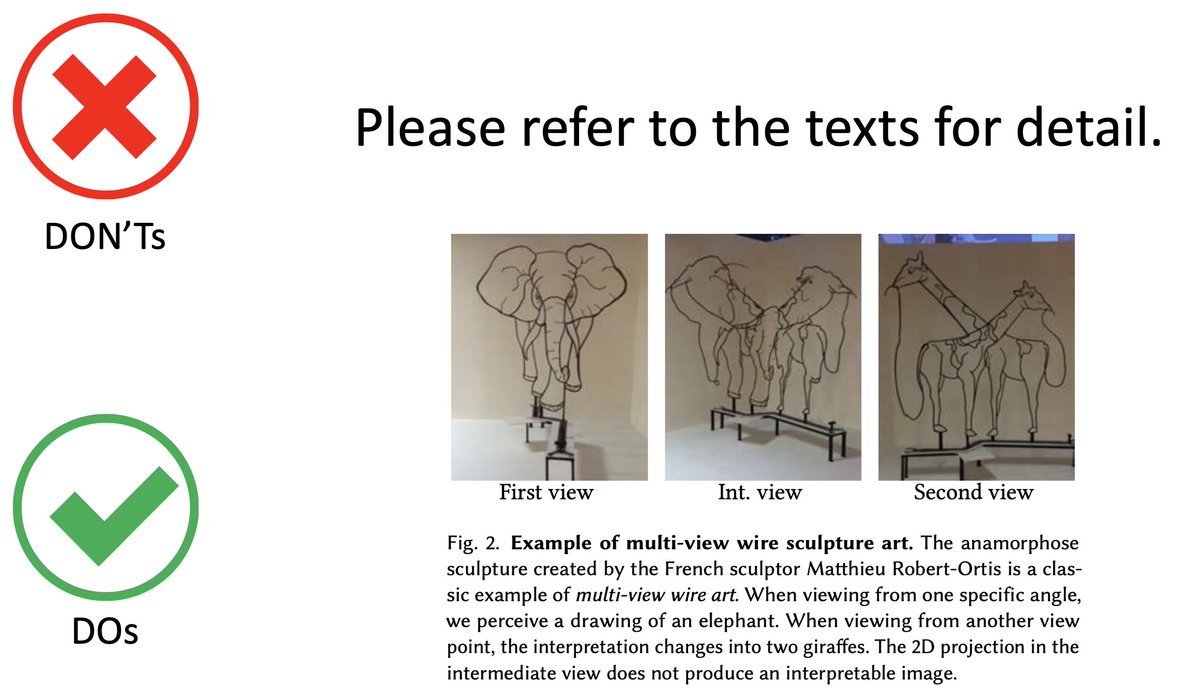Sharing one idea I found useful for paper writing:
Do NOT ask people to solve correspondence problems.
Some Dos and Don& #39;ts examples below:
*Figures*: Don& #39;t ask people to match (a), (b), (c) ... with the descriptions in the figure caption.
Do NOT ask people to solve correspondence problems.
Some Dos and Don& #39;ts examples below:
*Figures*: Don& #39;t ask people to match (a), (b), (c) ... with the descriptions in the figure caption.
*Figure caption*
Use "self-contained" caption. It& #39;s annoying to dig into the texts and match them to the figures. Ain& #39;t nobody got time for that! https://abs.twimg.com/emoji/v2/... draggable="false" alt="⌚️" title="Armbanduhr" aria-label="Emoji: Armbanduhr">
https://abs.twimg.com/emoji/v2/... draggable="false" alt="⌚️" title="Armbanduhr" aria-label="Emoji: Armbanduhr">
Also, add a figure "caption title" (in bold fonts). It allows readers to navigate through figures quickly.
Use "self-contained" caption. It& #39;s annoying to dig into the texts and match them to the figures. Ain& #39;t nobody got time for that!
Also, add a figure "caption title" (in bold fonts). It allows readers to navigate through figures quickly.
*Notations*
Give specific, meaningful names to your math notations. For example, the readers won& #39;t need to go back and forth to figure what each term means.
Give specific, meaningful names to your math notations. For example, the readers won& #39;t need to go back and forth to figure what each term means.
*Which*
I found that many of my students love to use "which" in their sentences. I hate it ... because I often cannot figure out what exactly "which" refers to. Break it down into simple sentences and spell out what that subject of the sentence is.
I found that many of my students love to use "which" in their sentences. I hate it ... because I often cannot figure out what exactly "which" refers to. Break it down into simple sentences and spell out what that subject of the sentence is.
*Respectively*
It& #39;s hard to parse which corresponds to which in the sentence that ends with "respectively" (have to solve a long-range correspondence problem). Break them them so that one sentence talks about one thing.
It& #39;s hard to parse which corresponds to which in the sentence that ends with "respectively" (have to solve a long-range correspondence problem). Break them them so that one sentence talks about one thing.
*Citations*
People like to use many acronyms for their methods. It may be hard for readers to memorize/match which method/dataset/metric you are referring to. Adding citations is an easy way to fix this.
People like to use many acronyms for their methods. It may be hard for readers to memorize/match which method/dataset/metric you are referring to. Adding citations is an easy way to fix this.
*Names for notations*
When using notations in the sentences, mention their "names" as well. The readers won& #39;t need to flip through your papers to look up what these notations mean.
When using notations in the sentences, mention their "names" as well. The readers won& #39;t need to flip through your papers to look up what these notations mean.
*Connect figures with equations, notations, and sections*
I view the overview figure in a paper a centralized hub that connects all the important equations, notations, and sections in one place. This makes it easy for people to understand how everything fits together.
I view the overview figure in a paper a centralized hub that connects all the important equations, notations, and sections in one place. This makes it easy for people to understand how everything fits together.
*Tables*
Factorize the variants/attributes of different methods so that it becomes clear to compare one with another.
Factorize the variants/attributes of different methods so that it becomes clear to compare one with another.
*One table, one message*
Decompose your big table so that each table conveys exactly one thing. This avoids people from having to compare results from distant rows. Having multiple smaller tables gets the point across easier. (Don& #39;t worry about the redundancy.)
Decompose your big table so that each table conveys exactly one thing. This avoids people from having to compare results from distant rows. Having multiple smaller tables gets the point across easier. (Don& #39;t worry about the redundancy.)

 Read on Twitter
Read on Twitter
 Also, add a figure "caption title" (in bold fonts). It allows readers to navigate through figures quickly." title="*Figure caption*Use "self-contained" caption. It& #39;s annoying to dig into the texts and match them to the figures. Ain& #39;t nobody got time for that! https://abs.twimg.com/emoji/v2/... draggable="false" alt="⌚️" title="Armbanduhr" aria-label="Emoji: Armbanduhr">Also, add a figure "caption title" (in bold fonts). It allows readers to navigate through figures quickly." class="img-responsive" style="max-width:100%;"/>
Also, add a figure "caption title" (in bold fonts). It allows readers to navigate through figures quickly." title="*Figure caption*Use "self-contained" caption. It& #39;s annoying to dig into the texts and match them to the figures. Ain& #39;t nobody got time for that! https://abs.twimg.com/emoji/v2/... draggable="false" alt="⌚️" title="Armbanduhr" aria-label="Emoji: Armbanduhr">Also, add a figure "caption title" (in bold fonts). It allows readers to navigate through figures quickly." class="img-responsive" style="max-width:100%;"/>










